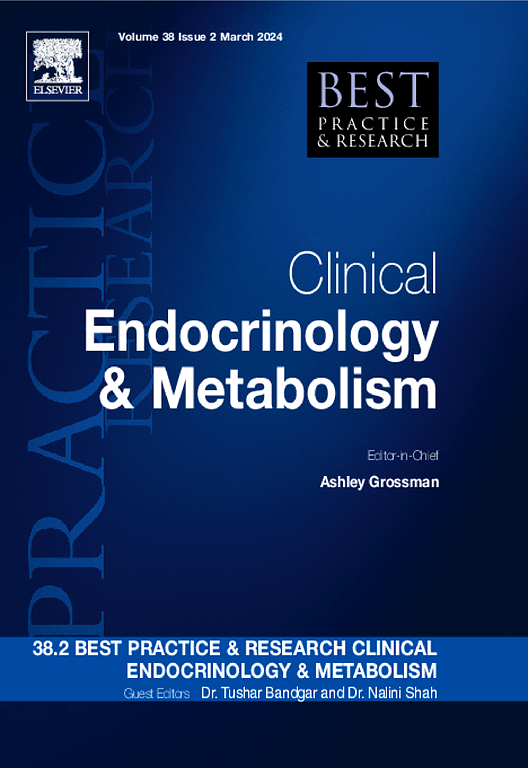Fluid and electrolyte disorders following traumatic brain injury
IF 6.1
1区 医学
Q1 ENDOCRINOLOGY & METABOLISM
Best practice & research. Clinical endocrinology & metabolism
Pub Date : 2025-05-01
DOI:10.1016/j.beem.2025.102014
引用次数: 0
Abstract
Abnormalities in salt and water balance are common following traumatic brain injury (TBI), manifesting clinically as either as hypo- or hypernatraemia. Dysnatraemia is associated with a greater risk of secondary brain injury from resultant changes in brain fluid levels, greater morbidity, longer length of hospital stay and in the case of hypernatraemia, greater mortality following TBI. Dysnatraemia occurs in the acute phase following TBI, is often transient and resolves in the majority of patients with recovery from the initial insult. Hyponatraemia secondary to the syndrome of inappropriate antidiuretic hormone is the commonest electrolyte disturbance following TBI although, iatrogenic causes and ACTH deficiency are important differentials to consider. Cerebral salt wasting syndrome is a rare cause of hyponatraemia following TBI. Acute symptomatic hyponatraemia predisposes to seizures and cerebral oedema and may be catastrophic, particularly if inappropriately treated. Hypernatraemia following TBI is most often due to AVP deficiency (AVP-D) and is an independent predictor of mortality. AVP-D is related to the severity of injury and is a poor prognostic indicator following TBI, often heralding rising intracranial pressure and death. In both hypo- and hypernatraemia early detection and prompt appropriate management is often life-saving. In this review we will discuss the pathophysiology of salt and water disorders following traumatic brain injury and provide detailed guidance on the approach to hypo- and hypernatraemia in this context.
外伤性脑损伤后体液和电解质紊乱。
盐和水平衡异常在创伤性脑损伤(TBI)后很常见,临床表现为低钠血症或高钠血症。钠血症异常与脑外伤后继发性脑损伤的更大风险、更高的发病率、更长的住院时间以及在高钠血症情况下更高的死亡率相关。钠血症异常发生在脑外伤后的急性期,通常是短暂的,大多数患者从最初的损伤中恢复后就会消退。低钠血症继发于不适当的抗利尿激素综合征是TBI后最常见的电解质紊乱,尽管医源性原因和ACTH缺乏是需要考虑的重要区别。脑盐消耗综合征是脑外伤后低钠血症的罕见病因。急性症状性低钠血症易引起癫痫发作和脑水肿,特别是如果治疗不当,可能是灾难性的。脑外伤后的高钠血症通常是由于AVP缺乏(AVP- d),是死亡率的独立预测因子。AVP-D与损伤的严重程度有关,是TBI后预后较差的指标,通常预示着颅内压升高和死亡。在低钠血症和高钠血症中,早期发现和及时适当的治疗往往是挽救生命的。在这篇综述中,我们将讨论创伤性脑损伤后盐和水紊乱的病理生理学,并在这种情况下提供低钠血症和高钠血症的详细指导。
本文章由计算机程序翻译,如有差异,请以英文原文为准。
求助全文
约1分钟内获得全文
求助全文
来源期刊
CiteScore
11.90
自引率
0.00%
发文量
77
审稿时长
6-12 weeks
期刊介绍:
Best Practice & Research Clinical Endocrinology & Metabolism is a serial publication that integrates the latest original research findings into evidence-based review articles. These articles aim to address key clinical issues related to diagnosis, treatment, and patient management.
Each issue adopts a problem-oriented approach, focusing on key questions and clearly outlining what is known while identifying areas for future research. Practical management strategies are described to facilitate application to individual patients. The series targets physicians in practice or training.

 求助内容:
求助内容: 应助结果提醒方式:
应助结果提醒方式:


